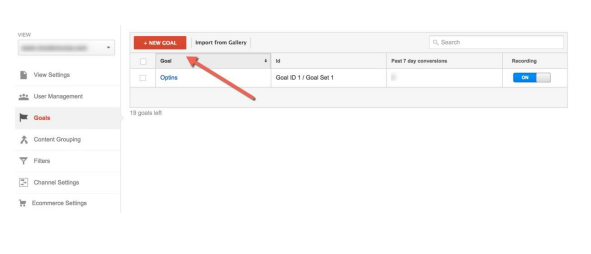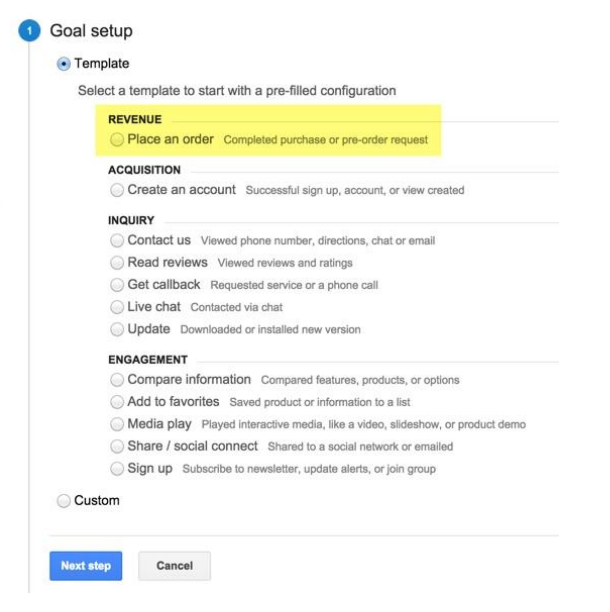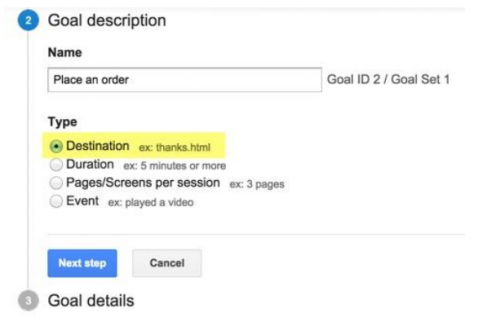Did you know that you can easily monitor the results of your traffic, using Google Analytics, by setting up and tracking each stage of your sales funnel?
You can do this using the “Goals” feature. The first thing you'll want to do it identify the different steps you want to measure.
For example:
- Step 1: Optin for newsletter
- Step 2: Download brochure
- Step 3: Visit pricing page
- Step 4: Schedule a consultation
- Step 5: Make a purchase
With these steps in mind, here’s how you can use Google Analytics Goals to track the results of all that traffic you've been generating!
Step 1:
 Login to your Google Analytics Account and click on “Admin” once you get to the dashboard. (Located at the top of the page.)
Login to your Google Analytics Account and click on “Admin” once you get to the dashboard. (Located at the top of the page.)
Once there, look on the third column, under “View”, you will see “Goals.”
Step 2:
Click on the red button that says “+ NEW GOAL”

You are limited to 20 goals and you can’t delete one once you’ve set it up (you can only edit)… so choose wisely.
Some initial ones could be–
- Signed up for newsletter
- Purchased Product A
Step 3:
Choose a template–there are 4 main templates to choose from:
- Revenue: Used to track sales generated by a specific product or service; which requires you to set a destination URL. Meaning, you have to assign a page that customers will be directed to after they make a purchase. Be sure your online shopping cart easily allows you to set the destination url after a purchase before attempting to set this up.
- Acquisition: Used to someone who creates an account or registers as a user on your website.
- Inquiry: Use this to track inquiry level engagement on your site. In other words, you can track metrics such as how many people visited your contact us page. How many people downloaded a sales brochure? How many people contacted you via live chat?
- Engagement: Use this to track leads or opt-ins to your email marketing list. You will need to use the thank-you page that your leads land on after opting in as the destination urls.

Step 4:
Setup Your Goal Description.
Goal Name: Name your goal something you’ll quickly recognize
Goal Type: There are four types of goals; URL Destination, Time on Site, Pages/Views, and Event.

- Destination: Use this goal to determine how many visitors reached a specific page on your site. For example, how many people reached your thank you page after opting in.
- Duration: Use this goal to determine how much time your visitors were on a specific page. For example if you have a page with a 3 minute video on it, you can measure how many people reached a goal of 3 minutes which could mean they watched the entire video.
- Pages/Screens per session: One important metric for SEO is the average number of pages your visitors visit while on your site. Measuring how many people reached a minimum of 3 pages can help you to improve your SEO.
- Event: Use this goal to measure specific actions on your site such as downloaded a brochure or watched a video.
- Case Sensitive: Are the URLs you entered above case sensitive? If so check this.
- Goal Value: If your goal completion has a dollar value, enter it here. Example: If your product sells for $100 and you know that 20% of the people who visit the page will buy, you could assign a $20 value to your goal. (NOTE: If you use the Ecommerce feature of Google Analytics to track purchases, you won't need to enter a value here in most cases.)
You can also activate Goal Funnel tracking if you like. Once you're done, click “Save Goal.”
Finally, be sure to check your goal to make sure that it’s tracking correctly. You can see this instantly in the Realtime “Conversions” report. (Or, when you're setting up your Goal, you can click the “Verify Goal” link to double-check your setup).
If you have questions, be sure to leave it in the comment section below. And if you found this post helpful, feel free to share it with others.
– Mercer
